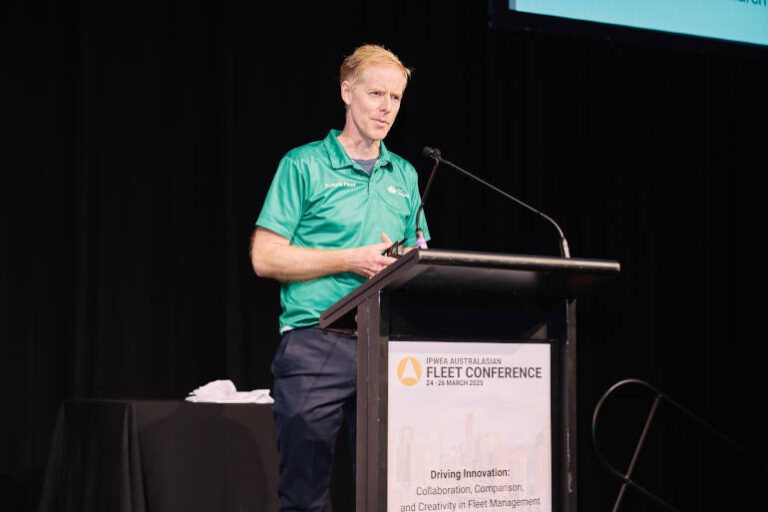At the 2025 IPWEA Fleet Conference in Brisbane, Brendan Ling from Logan City Council shared a grounded and practical approach to electrifying a local government fleet. While many are still navigating policy uncertainty, upfront costs and infrastructure challenges, Logan has quietly built a strategy that works—with no drama and a clear eye on what’s achievable.
A Strategy Rooted in Realism
Brendan kicked off with a reminder of how far we’ve come. Back in 2009, when he was working in council libraries, climate action meant telling people to switch off power points and hang their washing outside. Solar panels were the new tech back then, and he saw first-hand how community enthusiasm and government incentives led to mass adoption. From just 161 systems in the city in 2009 to over 55,000 today, solar is now on every second roof in Logan.
Logan’s fleet journey follows a similar path—start small, build trust, and scale up. Today, the council manages about 300 vehicles including passenger cars, trucks, and plant, and has been steadily integrating EVs since 2019.
The Green Fleet Strategy
In 2021, council endorsed its Green Fleet Strategy, which provided a framework for improving environmental outcomes across the fleet. This strategic buy-in has been critical. It means fleet decisions can align with pre-approved themes and targets without having to go back for fresh approval every time a new EV is added.
One early win? Logan’s passenger fleet is already over 50% low-emissions, mostly hybrids, with full EVs on the rise.
The Business Case for Cars, Not Trucks
In 2023, Logan worked with EVenergi to map out its EV transition plan. The analysis was clear:
- Cars: Most passenger vehicles could switch to EVs by 2030, with a strong business case and significant savings over business-as-usual.
- Trucks: No solid case until 2030, and even then only a handful could stack up financially. The issue? Low utilisation. Even with fuel and maintenance savings, the upfront cost is still too high without heavier daily use.
This honest assessment has helped Logan prioritise its efforts, rather than forcing the issue with tech that’s not ready or right for the job.
Scaling Up Carpool EVs
Since 2024, the council has been rolling out more EVs into its carpool, including the Kia Niro. Brendan says it’s the perfect fit—easy to drive, not too “techy”, and a great introduction for staff new to EVs. The regenerative braking paddles behind the wheel are a favourite feature.
All carpool EVs run on green power. The council estimates their electricity usage and purchases that amount from renewable sources. Chargers are mostly 7kW AC units, which suit the vehicles and daily usage patterns.
Smarter Leaseback EV Charging
Logan is also preparing to transition leaseback vehicles to EVs. The key challenge? Home charging.
As part of its planning for leaseback EVs, Logan City Council engaged external consultant Sarah Johnson from WLC Fleet Consulting to help navigate the complexities of home charging and reimbursement. Her advice supported a model where staff install their own chargers at home, avoiding Fringe Benefits Tax implications and simplifying asset management. This approach also streamlined the reimbursement process, allowing the council to pay a set rate per kilometre based on ATO guidelines, rather than monitoring electricity use or retail energy providers. The result is a practical, low-risk solution that supports EV uptake without overburdening internal systems.
Rather than installing chargers at staff homes—which triggers Fringe Benefits Tax and creates asset headaches—Logan has taken a smarter route. Staff install and pay for their own chargers using a council-approved checklist. Then, the council reimburses electricity usage at 4.2 cents per kilometre, based on ATO guidance. It’s simple, scalable, and works even if the staff member has solar.
The only requirement: plug in every night so the car is ready for daytime use by other staff. Range anxiety isn’t a big issue, with most vehicles travelling just 55km a day and rarely more than 200km.
Culture Change is Crucial
Logan’s success isn’t just about vehicles—it’s about people. Brendan highlighted a range of cultural initiatives:
- EV myth-busting sessions disguised as driver training.
- Case studies from early adopters to build trust.
- Future Fleet Supporters, a group of staff who champion EVs across departments.
- A branded Future Fleet Centre, repurposed from an old shed, that acts as a hub for charging and planning.
And they’ve backed up their workshop team too. Most technicians have completed MTAQ’s EV training, and an impact assessment found minimal risk to jobs—EVs still need servicing, just in different ways.
Lessons From Early Adopters
Those first two EVs purchased in 2019? Still going strong. After more than 100,000km, they showed no battery degradation—possibly because they were kept out of the sun and never fast-charged. Tyre wear was higher than expected, possibly due to frequent cornering around suburban streets.
Resale values were lower than hoped, so the council opted to retain one of the EVs for further long-term testing, rather than sell at a loss.
One overlooked benefit? Vehicle-to-load (V2L) capability. The Niro has already powered community event gear like TVs and monitors—no noisy generator required. Brendan suspects there’s a lot more potential there, yet to be tapped.
Why It All Matters
Brendan ended with a simple but powerful point: the shift to EVs isn’t just about saving money or testing new tech—it’s about climate change. Global temperatures are rising, driven by carbon emissions, and transport is a major contributor.
EVs are cleaner, cheaper to run, fun to drive, and better for local air quality. And Logan City Council is proving that with the right planning, the right vehicles, and the right people, you don’t need to wait for the perfect EV or the perfect policy to start making progress.






